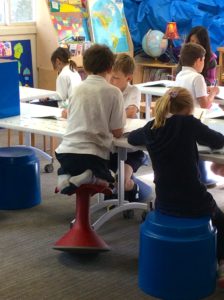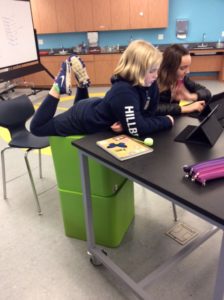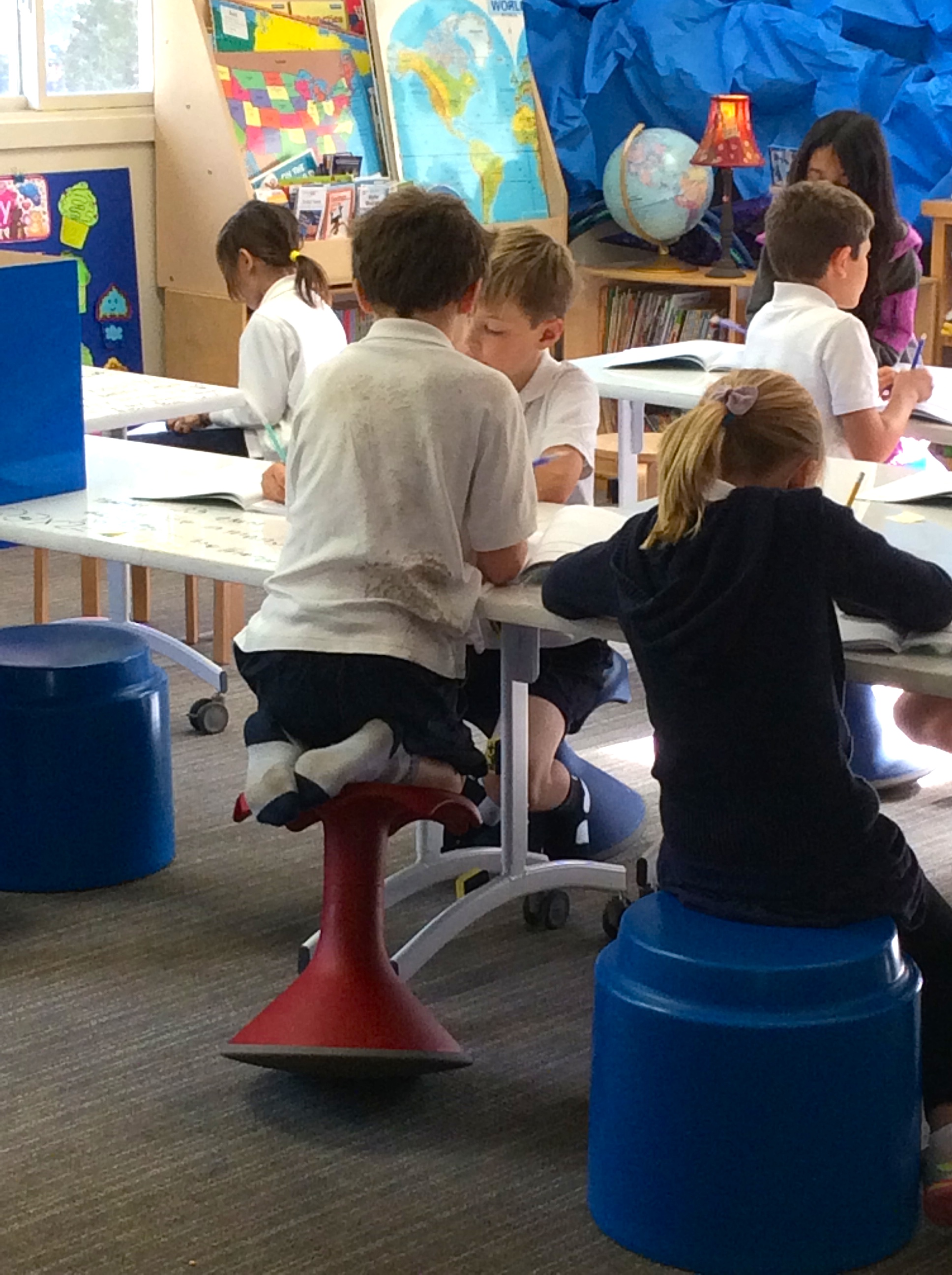“Once upon a time, Sara borrowed two wiggle stools from first grade…” That’s how second grade teachers Sara Lee, Penny Siebecker, and Taylor Hovish start this story. Last year, Sara and Penny had been intrigued by anecdotes from first grade about these colorful, plastic stools that look like oversized chess pieces with a rounded base. They were curious. Did students like the wiggle stools? And did they help learning in some way?
This year, as part of the Reimagining Classrooms (RC) project, Sara Lee ordered a larger set. The RC project kicked off last April after the parent community generously supported the effort through the 2014 Auction “fund a need.” The project invited teachers who wanted to significantly alter their physical classroom to take that risk, and to document their observations as we learned together from the changes. Teachers chose their own approach, guided by findings and key themes from previous years.
At Hillbrook, we know environment is not neutral–is not just a background upon which teaching and learning happen. We believe that environments invite and evoke different behaviors and types of thinking. And this year we are starting to understand we can use the physical environment to realize our goals of inclusion in the classroom as well. Alan Watts, best known for popularizing Eastern Philosophy in the United States, calls us all “wiggly objects.” And many teachers would emphatically agree. One of the key themes we have identified from previous classroom redesigns at Hillbrook is the importance of movement, not only in the sense of meeting a physical need, but also in the sense of creating flexibility in the variety of ways of being that can be practiced within one learning space. We aspire to create spaces that promote both fidgeting and flexibility.
 The second grade team observed a range of student responses to the wiggle stools: some loved the stools and wanted them all the time, others said they never wanted to try them again, some chose them only sometimes. The stools helped highlight how much second graders move. And they appeared to help some students meet this need while also joining, and perhaps focusing more on, group work.
The second grade team observed a range of student responses to the wiggle stools: some loved the stools and wanted them all the time, others said they never wanted to try them again, some chose them only sometimes. The stools helped highlight how much second graders move. And they appeared to help some students meet this need while also joining, and perhaps focusing more on, group work.
The conversations across the second grade team increasingly turned to these wiggly objects. Many students loved them and they appeared to change the class dynamic; but were they really helping students? In December, they sat down with sixth grade teacher and research designer Ilsa Dohmen to find out: is there something we can measure about how the stools serve students? Together they designed a simple study comparing the effect of sitting in either a still stool or a wiggle stool while completing mental math worksheets.
On two different days this December, second graders came into their classrooms with tables set either with all wiggle or all still stools. To warm up for the lesson, they were asked to do their best completing as many mental math problems as they could in five minutes. About ten days later, students came in and experienced an identical warm-up with the opposite chair type and a different, but analogous, worksheet.
 Teachers observed that during the data collection not as much movement happened as they were expecting. When Ilsa asked, Taylor and Sara told her they did not think the study worked to measure the effect they had observed during other class times. They felt the students had not wiggled as much as usual.
Teachers observed that during the data collection not as much movement happened as they were expecting. When Ilsa asked, Taylor and Sara told her they did not think the study worked to measure the effect they had observed during other class times. They felt the students had not wiggled as much as usual.
But it turned out, highly visible wiggle or not, it did work. We actually found that students sitting in a wiggle stool completed statistically significantly more math problems (with the same accuracy) than students sitting in a still stool. And in only five minutes! We suspect that this has to do with students being able to meet subconscious needs for micro-movement while also working more continuously. Instead of being a distraction to self and others, the movement can be better integrated with the class work, through the stool.
We were thrilled with the study results. Hillbrook is one of the few K-8 schools in the nation conducting this type of inquiry and it is so exciting to have significant findings we can share to inform further questions, and to guide decisions about how to design better spaces for children. In second grade, the study inspired the purchase of more wiggle stools. It also sparked discussions about ways to meet the physical needs of students who do not like the stools.
In his same lecture on wiggly objects Alan Watts continues “The physical world is fundamentally wiggly. We don’t notice this very much if we live in towns, and if we live in ordinary houses. Because, we build our streets and our homes so as to seem to be non-wiggly…. And so then we are also always in conflict with wiggliness.” He encourages his listeners to see their landscapes as blots, to recognize the contours and smudges that are present in the environment and to view what you are trying to create as emerging from these. At Hillbrook, we are continually striving to see our students as they are–to know them individually. Research studies like these allow us to isolate and measure the impact of specific actions or changes. And the results inform us all as we create ways for them to thrive as learners, both wiggly and still.
